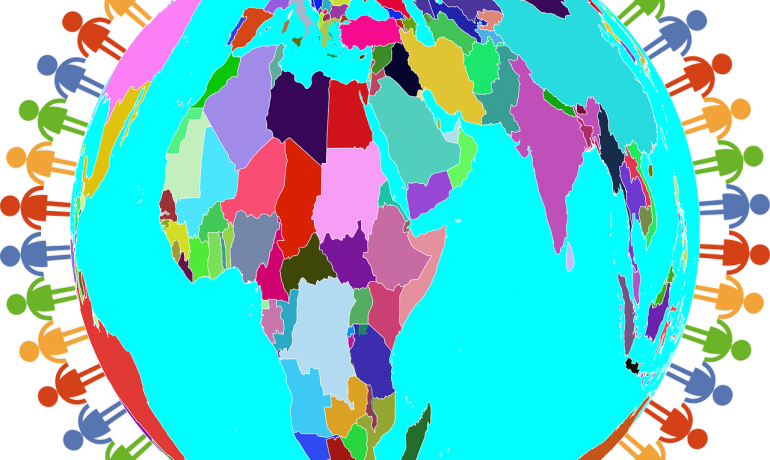Our second global driver of change has, for a long time, been Geo-politics. In our definition this includes a move towards a “polymodal world” – changing balances of global power dynamics – and relative economic growth and inequality.
![]()
This view had been based on the perception that the post cold-war “Washington consensus” was falling away. The geo-political dominance of the US has declined, with the Trump presidency in particular moving away from taking a global lead, and we are now seeing a much more multi-polar or polynodal world. Populism has led several developed countries to focus internally, leaving a space on the global stage for others to fill. The demographic trends we discussed in a previous blog reinforced this perception.
In 2022 of course we saw geo-politics burst into the foreground, with both Russia and China becoming more aggressive. Other regional powers may also begin to emerge; and the way smaller countries navigate between the power blocs will be increasingly varied.
RUSSIA
Russia’s invasion of Ukraine has highlighted these dynamics. On the one hand this has led to greater co-operation and consensus in the West, with Sweden and Finland renouncing their traditional neutrality and applying to join Nato. Concerns abound that Russia may be seeking to extend its influence back to a “Greater Russia” model, risking confrontation and a new cold war.
But outside of the West, the situation is often viewed differently. India has refused to condemn Moscow and join Western-led sanctions. Each of the other major powers—the United States, Russia, and China—are looking to keep India onboard. India could carve out an independent superpower role, hasten the transition to a multipolar international system, and even gain a permanent United Nations Security Council seat.
African countries see things differently as well. The lack of Ukrainian grain supplies and higher prices could be disastrous, especially as many countries are suffering from droughts. Western aid is being diverted to Ukraine, further exacerbating the problem. Russia launched a charm offensive. Mostly, African countries just want the war to stop.
Climate change will also affect Russia’s global position. Melting ice caps means ships can use the Arctic shortcut, taking two weeks off a voyage from Shanghai to Rotterdam compared with existing routes. The Northern Sea Route, which extends from the Kara Sea to the Bering Strait, is under Russian control. A report, The Next Front? Sino-Russian expansionism in the Arctic and a UK response, suggests that President Putin is about to pass a law that requires Russian pilotage of vessels seeking to use the Northern Sea Route. Russia is re-opening 50 Soviet-era military posts in the Arctic.
CHINA
China’s long-term future is also inherently uncertain. On the one hand its military, political and economic expansionism demonstrate President XI’s will to extend its influence, even dominance. On the other, the economic tensions arising from the imminent demographic shift and rumours of internal political unrest suggest that instability could be around the corner. The Sino-Russian relationship is a constant delicate dance, seemingly having cooled during the year.
On the military side:
- China’s attitude to Taiwan US analysts fear that Taiwan could not be defended against a direct attack.
- Nato’s 2022 “Strategic Concept” report identifies China as a “systemic challenge” and determines to “protect against the PRC’s coercive tactics”;
- China’s intimidation of countries around the South China Sea continues, including militarising artificial islands.
- China has signed a security pact with the Solomon Islands and is wooing several other Pacific islands. This could enable it to position naval assets in the region undermining US and Australian positions.
- To India’s chagrin, China exploited Sri Lanka’s weak economic position to force it to allow a “spy ship” to dock there.
Economically:
- The Belt and Road Initiative: this global infrastructure development strategy adopted by the Chinese Government in 2013 is a way of projecting economic power. As of March 2022, 146 countries were listed as having signed up to the BRI. Examples of BRI investments include ports, skyscrapers, railroads, roads, bridges, airports, dams, coal-fired power stations, and railway tunnels.
- The BRI has been criticised as neo-colonialism and debt trap diplomacy. Beijing pressured Tajikistan to handover 1,158 km2 territory, for wiping off about half its debt. Other nations with a similar risk are Pakistan, Madagascar, Mongolia, Maldives, Kyrgyzstan, Montenegro, Sri Lanka, and Laos all of which have borrowed large sums from China. Some academics however describe these concerns as “overblown”.
- China waived debt for 17 African countries to argue against western bullying.
On the other hand:
- The Chinese economy is under pressure, from Covid lockdowns and structural issues.. In July 2022, China had its weakest quarterly growth in 2 years, as COVID-19 lockdowns in major cities hit production.
- The costs of being a superpowerare already seemingly causing concern, and spending on the Belt and Road Initiative has been falling since 2017.
- The Chinese property market is in difficulty: property sales could fall by one-third this year, as people lose faith in the market and pressure increases on struggling developers to complete presold apartments.
- Huaweii suggested that “the next decade will be a very painful historical period, as the global economy continues to decline,”
Internal politics are a challenge too
- The demographic pressures of an ageing population will bring economic and political challenges.
- The unity of the Chinese Communist Party may itself start to fracture as President Xi is said to be facing widespread oppositionwithin the party. The economic impact of an untenable zero-Covid policy is leading to rumours of President Xi’s demise.
- Discontent has been building for a while. There has been a succession of highly unusual leaks from the Chinese elite all seemingly designed to stress President Xi’s direct responsibility for the country’s problems.
We could easily create several very contrasting scenarios of China’s future.
AFRICA
As the one region not facing population decline by the end of the century, Africa has an opportunity to exploit that growth and build on a “demographic dividend”.
Nigeria’s working-age population is forecast to grow over the course of the century (from 86 million in 2017 to 458 million in 2100). Its economy will grow rapidly and it could rise to be have the 9th largest GDP by 2100.
In Tanzania, the number of dependents per 100 people of working age is projected to fall from 98 to 60, opening up prospects of economic growth.
The African Development Bank’s African Economic Outlook makes it clear that the pandemic and Russia-Ukraine war could leave a lasting impression over several years. GDP growth of 6.9% in 2021 is forecast to slip to 4.1% in 2022 and remain at that level in 2023. Climate change is seen as the most existential challenge to Africa’s development today.
The Covid pandemic could have even more disruptive effects. Studies suggest that disease outbreaks may initially suppress social disturbances, by limiting contact, but encourage it in the longer term.
SUPPLY CHAINS
The recent shocks to the economic system from the pandemic and war have exposed the fragility of globalised supply chains, whether in grain, fuel or semi-conductors. Security of supply has leapt up the list of concerns for companies and countries alike. The benefits of “Just in time” sourcing are beginning to be outweighed by the risks. Ultimately the more cautious approach adopted will prove a drag on growth globally, though there will be local opportunities emerging.
Written by Huw Williams, SAMI Principal
The views expressed are those of the author(s) and not necessarily of SAMI Consulting.
Achieve more by understanding what the future may bring. We bring skills developed over thirty years of international and national projects to create actionable, transformative strategy. Futures, foresight and scenario planning to make robust decisions in uncertain times. Find out more at www.samiconsulting.co.uk
If you enjoyed this blog from SAMI Consulting, the home of scenario planning, please sign up for our monthly newsletter here and/or browse our website.
Image by Gordon Johnson from Pixabay


